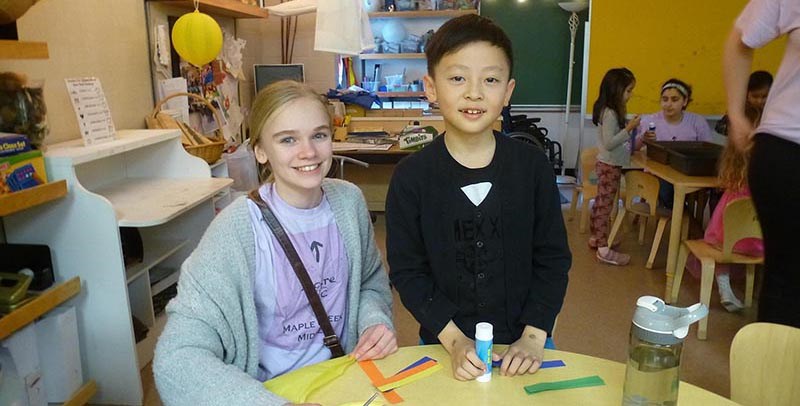Nine years have passed since two Nova Scotia teens donned pink T-shirts in support of a Grade 9 boy who was tormented when he wore a pink shirt to school. Since then, with the promotional heft of CKNW behind it, Pink Shirt Day in B.C. has become synonymous with anti-bullying initiatives. But what's changed since then? In a two-part series beginning today, during Random Acts of Caring Week, and continuing next Wednesday — Pink Shirt Day — The Tri-City News looks at changes in how bullying is addressed in School District 43.
***
Harpreet Esmail's class at Meadowbrook elementary school in Coquitlam is abuzz with chatter as students move into groups to do a craft.
Like a flock of birds that knows instinctively when to take flight, the groups are formed, made up of a blend of Meadowbrook Grade 1 and 2 students and Grade 6s and 7s from Melissa Burdock's class at Maple Creek middle school.
In years past, a group of such different ages might split off between genders, age or ability. Not so with this bunch of kids.
At one table, a boy in a wheel chair carefully applies glue to coloured construction paper while a couple of older girls mill around him gathering supplies. At another, two older boys dressed in mauve-coloured shirts depicting Maple Creek middle school's RAC (Random Acts of Caring) Club, bring a smaller, younger boy to their team to make the happy face craft. At the other end of the table, an older girl pairs up with a younger boy.
It is noisy but productive.
"Anti-bullying is not a one-off in this district. In fact, it's how we talk about, teach, model and create an ongoing safe, caring, learning environment that is both implicit and explicit," Marna McMillan, safe and caring schools coordinator
This is school today, for the most part — a friendly, welcoming place where bullying isn't tolerated. What educators are finding out is that when it comes to bullying, it's best to inoculate children early.
And so, for hundreds of students, including Maple Creek kids — who were out doing Random Acts of Caring this week, the 10th year of this local initiative — doing something kind without expecting anything in return is part of the school culture.
It's not that Pink Shirt Day on Feb. 24 isn't important, it's just that it's only one of many school-based efforts to foster school connectedness, teach children social skills and help them resolve conflicts in peaceful ways — all important social and emotional competencies, according to Marna McMillan, the district's safe and caring schools co-ordinator.
"It's not [that a program targeting] bullying is bad, but more of what are we doing are our initiatives like RAC is to help people in the community to get to know each other, to get beyond ourselves, because when does bullying happen? It happens when we don't know each other."
In other words, preventing bullying is a year-round venture that starts with role modelling and a bit of social engineering, something adults outside the education system may have to learn.
From elementary school buddy programs to self-regulation initiatives (where students learn to monitor and control their stress and anxiety), as featured recently in The Tri-City News, and Maple Creek middle's RAC club, schools are finding different ways to build empathy, compassion and understanding. The idea is to prevent situations where one person may pick on another.
In one important way, schools are helped to achieve this important goal by the new B.C. curriculum, which addresses bullying specifically in the physical health education core area.
"Anti-bullying is not a one-off in this district. In fact, it's how we talk about, teach, model and create an ongoing safe, caring, learning environment that is both implicit and explicit," McMillan said.
And it's not just students doing the learning, she said, but teachers, too.
"What are we focusing that creates a connected, belonging place: in the way we know everybody's name, the way we set up our self-regulation classrooms, what are we doing specifically to teach kids how to handle conflict."
And that's how it goes in Esmail's class, where kids of different ages, genders and abilities will work together on a craft — a lesson that everyone could learn as Pink Shirt Day approaches.
Anti-Bullying Resources
• ERASEBullying continues to offer training to school districts, including SD43, and there is information and resources for parents, including how to keep kids safe online. Find out more at erasebullying.ca
• To get help, text 211. The Port Coquitlam-based group I Am Someone partnered with bc211 for a texting platform and referral service available to youth struggling with mental health issues, grief, loss and bullying. The 211 service is for teens from the Sunshine Coast to Hope, open daily from 8 a.m. to 11 p.m.; adults can also use the texting service.
• B.C.s new curriculum addresses bullying specifically in the physical health education subject. Find out more at curriculum.gov.bc.ca



